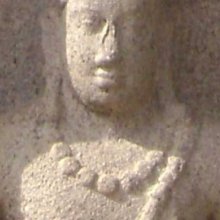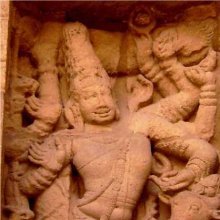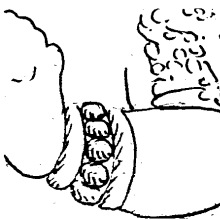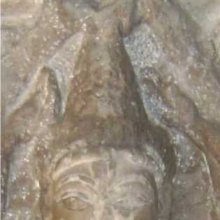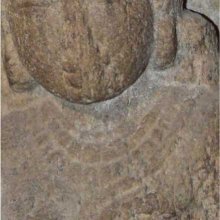Pearl: 3 definitions
Introduction:
Pearl means something in Hinduism, Sanskrit, the history of ancient India. If you want to know the exact meaning, history, etymology or English translation of this term then check out the descriptions on this page. Add your comment or reference to a book if you want to contribute to this summary article.
Images (photo gallery)
(+4 more images available)
In Hinduism
Yoga (school of philosophy)
Source: ORA: Amanaska (king of all yogas): A Critical Edition and Annotated Translation by Jason BirchPearls are denoted by the Sanskrit term Mauktika, according to the Amanaska Yoga treatise dealing with meditation, absorption, yogic powers and liberation.—Accordingly, as Īśvara says to Vāmadeva: “[...] [Now], I shall define the nature of that highest, mind-free absorption which arises for those devoted to constant practice. [...] [The yogin] who has remained in absorption continually for twenty-four years, [gains] the Siddhi of the Śakti element. Indeed, he becomes absorbed in the Śakti element. [The Yogin] will see the entire universe like a pearl (mauktika) held in [his] hand and truly understand its essential nature [to be] in his own body. [...]”.

Yoga is originally considered a branch of Hindu philosophy (astika), but both ancient and modern Yoga combine the physical, mental and spiritual. Yoga teaches various physical techniques also known as āsanas (postures), used for various purposes (eg., meditation, contemplation, relaxation).
Ayurveda (science of life)
Rasashastra (Alchemy and Herbo-Mineral preparations)
Source: History of Science in South Asia: Making Gems in Indian Alchemical LiteraturePearls were commonly manufactured in ancient India, using alchemical formulas, as explained according to the Vādakhaṇḍa section of the Rasaratnākara (lit. “jewel mine of mercury”): a 13th century alchemical work in Sanskrit written by Nityanātha.—Verses 1-40 of chapter 19 continues with a series of formulations for creating gems, such as Pearls. These formulations stand on their own and do not seem to be integrated into a larger alchemical programme of making mercurial elixirs.

Āyurveda (आयुर्वेद, ayurveda) is a branch of Indian science dealing with medicine, herbalism, taxology, anatomy, surgery, alchemy and related topics. Traditional practice of Āyurveda in ancient India dates back to at least the first millenium BC. Literature is commonly written in Sanskrit using various poetic metres.
India history and geography
Source: Singhi Jain Series: Ratnaprabha-suri’s Kuvalayamala-katha (history)1) Pearls and Jewels were traded under the cloth using hand-signs, according to ancient Indian trading traditions, as was vividly depicted in the Kathās (narrative poems) such as Uddyotanasūri in his 8th-century Kuvalayamālā (a Prakrit Campū, similar to Kāvya poetry).—[...] In the trade of precious stones and gems, it was customary not to utter the value loudly by word of mouth but through a piece of cloth or a scarf on the jewels and pearls to be sold and then the buyer and seller put their hands under the cloth, both of them negotiating by means of some signs conveyed through the fingers of the hands. It is also stated that after taking other goods in exchange and before leaving the place the foreign merchant makes some charitable gifts to the local religious teachers and establishments. [...]
2) Pearls commonly decorated the Vimānas (temple complex) of ancient India, according to the Kuvalayamālā.—Page 92.24-31: A Devī-vimāna is described as being decorated with rubies, pearls-pendants and festoons, rows of bells attached to banners, rows of vaijayantī flags fixed on the top, lotus-medallions formed by the inset work of rubies, figures of the lotus-pond and thus giving appearance of Padma-vimāna. [...]

The history of India traces the identification of countries, villages, towns and other regions of India, as well as mythology, zoology, royal dynasties, rulers, tribes, local festivities and traditions and regional languages. Ancient India enjoyed religious freedom and encourages the path of Dharma, a concept common to Buddhism, Hinduism, and Jainism.
See also (Relevant definitions)
Starts with: Pearl acacia, Pearl barley, Pearl gromwell, Pearl millet, Pearl onion, Pearl-festoon, Pearl-plant, Pearls-string, Pearlu, Pearlwort, Pearly everlasting, Pearly gates.
Ends with: Sea pearl.
Full-text (+1285): Mauktika, Mukta, Muktaphala, Muktajala, Hara, Shuktija, Shukti, Muktaguna, Mani, Induratna, Mauktikaprasava, Ekayashtika, Shuktika, Shankhaja, Hemavala, Muktakalapa, Muktahara, Meghaja, Shankhamukta, Muktavali.
Relevant text
Search found 245 books and stories containing Pearl; (plurals include: Pearls). You can also click to the full overview containing English textual excerpts. Below are direct links for the most relevant articles:
Cosmetics, Costumes and Ornaments in Ancient India (by Remadevi. O.)
1.2. Materials (b): Pearl < [Chapter 3 - Ornaments]
2.4. Various other Neck Ornaments < [Chapter 3 - Ornaments]
2.4. Neck Ornaments (d): Pearl Necklaces < [Chapter 3 - Ornaments]
Rasa Jala Nidhi, vol 3: Metals, Gems and other substances (by Bhudeb Mookerjee)
Part 1 - Characteristics of Pearl (mukta) < [Chapter XVI - Gems (4): Mukta (pearl)]
Part 1 - Characteristics of Diamond (vajra or hiraka) < [Chapter XIII - Gems (1): Vajra or Hiraka (diamond)]
The Garuda Purana (by Manmatha Nath Dutt)
Chapter LXIX - Tests of Pearls < [Agastya Samhita]
Chapter LXVIII - Description of the origin of gems in the treatise on Ratna Pariksa (test of gems) < [Agastya Samhita]
Chapter CXVII - The Ananga trayodasi Vratam < [Brihaspati (Nitisara) Samhita]
Brihat Samhita (by N. Chidambaram Iyer)
Chapter 81 - On Pearls (muktā-lakṣaṇa)
Chapter 73 - On Umbrellas (chatra-lakṣaṇa)
Sahitya-kaumudi by Baladeva Vidyabhushana (by Gaurapada Dāsa)
Text 7.112 < [Chapter 7 - Literary Faults]
Text 1.9 < [Chapter 1 - The Purpose of Poetry]
Text 4.16 < [Chapter 4 - First-rate Poetry]
Garga Samhita (English) (by Danavir Goswami)
Verse 3.6.36 < [Chapter 6 - The Test of Śrī Kṛṣṇa]
Verses 3.6.10-11 < [Chapter 6 - The Test of Śrī Kṛṣṇa]
Verse 3.6.28 < [Chapter 6 - The Test of Śrī Kṛṣṇa]
Related products
(+23 more products available)
